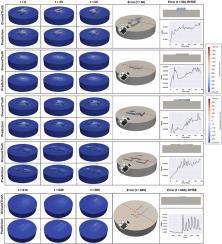迁移学习使几何、工艺和材料不可知的RGNN用于定向能沉积的温度预测
IF 11.1
1区 工程技术
Q1 ENGINEERING, MANUFACTURING
引用次数: 0
摘要
定向能沉积中的热模拟是一个活跃的兴趣领域,因为沉积过程中温度场的演变是影响最终构建性能的关键变量。代理机器学习模型能够加速替代有限元分析,但在推广新的推理条件时往往面临挑战。在这项工作中,我们提出了一种几何和过程无关的递归图神经网络(RGNN),该网络通过图节点和边保持网格连接。与有限元分析相比,RGNN模型提供的热预测计算速度快了405倍。此外,我们通过微调来适应具有不同传热特性的新材料系统的预训练模型,证明了迁移学习(TL)的有效性。我们在一个具有挑战性的场景中评估TL模型,在该场景中,它使用新的几何形状成功地预测了扩展1000个时间步长的热行为。与预训练模型相比,TL模型显示出更低的随时间累积误差,而只需要一小部分训练数据和训练时间。TL预测结果与红外成像实验温度场吻合较好,显示了其鲁棒性和适应性。本文章由计算机程序翻译,如有差异,请以英文原文为准。

Transfer learning enabled geometry, process, and material agnostic RGNN for temperature prediction in directed energy deposition
Thermal simulation in directed energy deposition is an area of active interest, as the evolution of the temperature field during deposition is a key variable that affects resulting build properties. Surrogate machine learning models enable an accelerated alternative to finite element analysis, but often face challenges in generalizing new inference conditions. In this work, we present a geometry- and process-agnostic recurrent graph neural network (RGNN) that preserves the mesh connectivity through graph nodes and edges. Compared to finite element analysis, the RGNN model provides thermal predictions up to 405 times faster in computational speed. Furthermore, we demonstrate the effectiveness of transfer learning (TL) via fine-tuning to adapt the pretrained model for a new material system with distinct heat transfer characteristics. We evaluate the TL model in a challenging scenario, where it successfully predicts thermal behavior over an extended 1000 time steps using a new geometry. The TL model exhibits much lower error accumulation over time compared to the pretrained model, while requiring only a fraction of training data and training time. The TL predictions show a good match with an experimental temperature field obtained from IR imaging, demonstrating its robustness and adaptability.
求助全文
通过发布文献求助,成功后即可免费获取论文全文。
去求助
来源期刊

Additive manufacturing
Materials Science-General Materials Science
CiteScore
19.80
自引率
12.70%
发文量
648
审稿时长
35 days
期刊介绍:
Additive Manufacturing stands as a peer-reviewed journal dedicated to delivering high-quality research papers and reviews in the field of additive manufacturing, serving both academia and industry leaders. The journal's objective is to recognize the innovative essence of additive manufacturing and its diverse applications, providing a comprehensive overview of current developments and future prospects.
The transformative potential of additive manufacturing technologies in product design and manufacturing is poised to disrupt traditional approaches. In response to this paradigm shift, a distinctive and comprehensive publication outlet was essential. Additive Manufacturing fulfills this need, offering a platform for engineers, materials scientists, and practitioners across academia and various industries to document and share innovations in these evolving technologies.
 求助内容:
求助内容: 应助结果提醒方式:
应助结果提醒方式:


